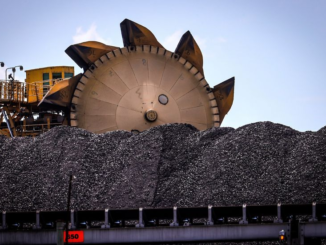
In a bold escalation of its campaign against Russia’s energy infrastructure, Ukraine has claimed responsibility for a drone strike on the Saratov Oil Refinery in Russia’s Volga region overnight on November 11, 2025. This marks the second attack on the facility this month, the fifth reported strike this fall, and the seventh overall in 2025. Owned by state-controlled Rosneft PJSC, the refinery processes approximately 4.8 million tons of crude oil annually (around 96,000 barrels per day), producing gasoline, diesel, and other fuels critical to Russia’s military and domestic needs. Ukrainian military officials described the strike as causing multiple explosions followed by a “massive fire” in the targeted area, with damage assessments ongoing.
Visual evidence from local sources and social media footage reveals significant fires illuminating the night sky, with bright orange flames and thick smoke plumes rising from the refinery complex. One video captures a series of explosions lighting up the horizon, suggesting hits on storage tanks or processing units, while images show an intense glow over the industrial site, consistent with a large-scale blaze.
Russian authorities reported intercepting several drones but acknowledged a fire at the site, which temporarily halted operations at nearby Saratov Airport. Kyiv’s General Staff emphasized that the attack aligns with its strategy to disrupt Moscow’s oil-processing capabilities and curtail energy revenues funding the ongoing war.
A Pattern of Targeted Strikes on Russian Energy Assets
This latest incident is part of a sustained Ukrainian drone offensive against Russian refineries, which has intensified dramatically in 2025. Ukraine has focused on long-range strikes to hit deep inside Russian territory, aiming to degrade Moscow’s fuel production and logistics. While Ukraine has not launched attacks on refineries in other countries, its operations have primarily targeted Russian facilities, with ripple effects felt globally through disrupted oil supplies.Key examples from recent months include:
November 3, 2025: Another strike on the Saratov Refinery, where a drone targeted a crude distillation unit but was partially thwarted by anti-drone netting; a fire erupted elsewhere on the premises.
October 29, 2025: Drones hit the Kstovo Refinery in Nizhny Novgorod, causing explosions and fires that burned for two days, halting operations at the Sibur plant.
September 28, 2025: Attack on the Kuibyshev Refinery in Samara Oblast, damaging primary and secondary refining units shortly after a major overhaul.
August 14, 2025: Volgograd Refinery struck, with drone debris igniting a fire detected by satellite imagery.
August 7-8, 2025: Afipsky Refinery in Krasnodar Krai hit, sparking a fire in a gas condensate unit that was extinguished by morning.
These are drawn from a broader pattern documented in various reports, including earlier strikes like the January 31 Volgograd attack and January 29 Kstovo hit.
Total Attacks Over the Last Several Months: A Tally of Disruption
From August to November 2025, Ukraine has launched at least 58 attacks on key Russian energy sites, with 29 specifically targeting oil refineries.
This surge represents a record intensity, with August seeing 14 refinery strikes alone and September adding eight more.
Overall in 2025, estimates suggest over 60 drone strikes on refineries, affecting more than half of Russia’s 38 major facilities at least once.
|
Month (2025)
|
Number of Refinery Attacks
|
Key Refineries Hit
|
Estimated Capacity Impact
|
|---|---|---|---|
|
August
|
14
|
Afipsky, Volgograd, others
|
~17% of total (1.2 million bpd)
|
|
September
|
8
|
Kuibyshev, multiple repeats
|
Up to 21% (1.4 million bpd)
|
|
October
|
~5-7 (partial data)
|
Kstovo, Saratov
|
Cumulative 500,000 bpd cut
|
|
November
|
2 (Saratov strikes)
|
Saratov
|
Ongoing assessments
|
These attacks have knocked out 17-21% of Russia’s refining capacity in peak periods, equating to 1.2-1.4 million barrels per day (bpd) offline.
The International Energy Agency (IEA) estimates a sustained cut of 500,000 bpd in output due to the strikes.
eRepairs are proving challenging; many facilities won’t fully recover until mid-2026, as Russia struggles with sourcing Western parts amid sanctions and repeated hits on the same sites.
Lost revenue calculations are complex, factoring in reduced refined product exports, increased crude oil shipments, and domestic shortages. Russia’s fossil fuel export revenues fell to a low of EUR 546 million per day in September 2025—the lowest since the pandemic—partly due to the strikes.
Estimates suggest a 30.4% drop in refinery throughput, with gasoline production down 16.3% and diesel by 37.5%.
Rough calculations based on a $10-20 per barrel refining margin and 500,000 bpd lost over several months point to billions in forgone revenue—potentially $5-10 billion annually if disruptions persist.
This includes slumped sales to near five-year lows in August and forced export bans on gasoline and diesel to stabilize domestic markets.
Impacts on Consumers and Global Oil Distribution
The strikes have hit Russian consumers hardest, sparking fuel shortages, queues at gas stations, and price hikes of about 10% for gasoline.
In regions like Volgograd and Krasnodar, sporadic blackouts and supply disruptions have compounded the pain, with diesel shortages affecting agriculture and transport.
Moscow has responded by boosting crude oil exports—up 10% in September—to offset lost refined product revenue, but this has strained global markets.
Internationally, the attacks have contributed to volatility in oil prices, with reduced Russian diesel and gasoline exports tightening supplies in Europe and Asia. While not catastrophic, they’ve added upward pressure on global benchmarks, potentially raising costs for consumers worldwide by a few cents per gallon.
Europe’s continued imports from Russia—totaling $1.35 billion monthly—underscore the interconnectedness, but the strikes are eroding Moscow’s energy leverage.
Distribution networks face delays, with Russia diverting more crude to India and China, altering trade flows and increasing shipping costs. As Ukraine’s drone capabilities evolve, these strikes could further reshape the energy landscape, pressuring Russia economically while highlighting vulnerabilities in global oil supply chains. For now, the Saratov blaze serves as a stark reminder of the war’s far-reaching energy fallout.






